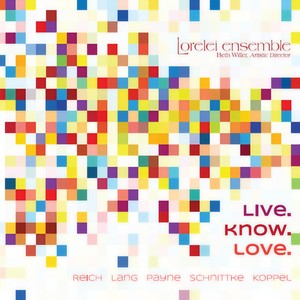
- 歌曲
- 时长
-
作曲家:Steve Reich( 斯蒂夫·莱许)
-
作曲家:David Lang
-
作曲家:Maggi Payne
-
作品集:Desertscapes
-
作曲家:David Lang
-
作曲家:Alfred Schnittke( 阿尔弗莱德·施尼科)
-
作曲家:Mary Montgomery Koppel
-
作曲家:David Lang
简介
To live. To know. To love. In a minimalist sense, these are perhaps the most basic earthly and spiritual responsibilities we possess. Life gives rise to knowledge, knowledge to love, and love perhaps to new life. The order of these is not crucial (they are rather cyclical, in fact). What is certain is that all three belong, at least in part, to this earth as basic elements of our existence. The minimalist artist creates a penetrating and awesome aesthetic from basic units – an honest and profound means of depicting the ineffable elements of our universe. The repetitive, cyclical nature of the style encourages a meditation on solitary elements—be it a syllable or a sentence, a single note or a musical phrase. These elements gain meaning as they evolve into more complex textures carrying basic yet vivid images and emotions. Describing the title track, Know what is above you, Steve Reich assigns relevance to an ancient Jewish prayer: “[it] suggests that we are not alone, that an Eternal being cares about us, that our every thought, word and deed has its effect on our character, our soul and on the souls of those around us.” The text at once acknowledges our need for love and the potential and power in each life, launching the narrative of this album. Oscillating between vivid images of the natural world and humanistic poetry, images of miraculous landscapes overlap with sentiments of desire, grief, urgency, and anticipation. The unassigned voice of David Lang's I live in pain and I want to live is rooted in human experience, while I lie transcends earthly love with the organic flowering of a profound melody out of an initially sparse texture. The “Eternal” is threaded through the album in images of the natural world. Maggi Payne's Desertscapes visits four unique desert landscapes, each simultaneously precious and powerful. Enveloped in undulating rhythms, additive textures, and shimmering vertical sonorities, one feels the morning mist rising off of a wintery Pyramid Lake, the broad expanse of Bryce Canyon, the parched, cracked floor of Death Valley, and the hot breath of the Kelso Dunes. Mary Montgomery Koppel's A la lune is grounded in a similarly organic compositional language. Melodies of a distinctly modal flavor address an all-knowing moon, requesting pardon for our “troubled quietnesses” and repetitive journeys. Alfred Schnittke's Stimmen der Natur abandons text entirely, relying solely on unison vocal lines offset by rhythmic discrepancies to depict the unified yet unpredictable nature of the cosmos. Illuminated by the vibraphone's evanescent overtones, ten voices depict the raw beauty of nature that is verbally inexpressible. In the making of this album, it became apparent that not only are these concepts universal, they are also intensely personal. As performers, our experiences with the texts were distinct, yet all somehow simultaneously represented in the music. It is precisely this phenomenon that preserves both diversity and unity: the stuff of great art.







